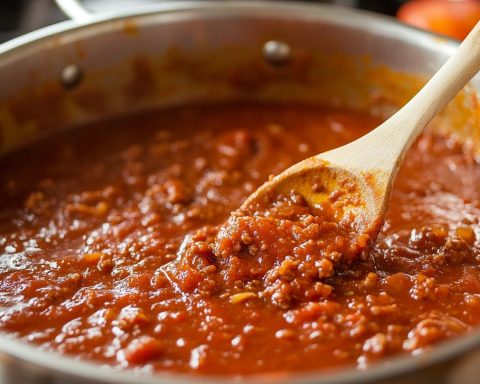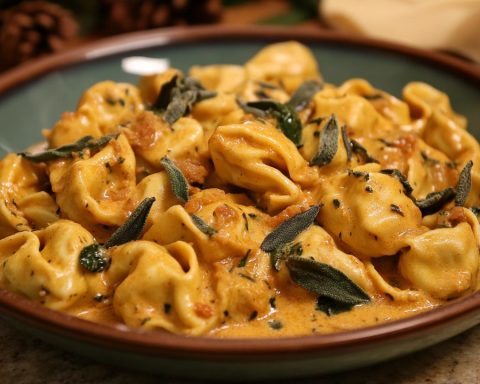Prepare to embark on a flavorful journey with Tysk Lökpaj, an exquisite Swedish-German onion pie that radiates warmth and comfort with each bite. This culinary gem brings together the rich tradition of Swedish and German fare, giving birth to a savory pie that effortlessly combines sweet caramelized onions, creamy cheese, and a buttery, flaky crust. Whether paired with a simple salad for a light lunch or served as an appetizing entrée at a dinner party, this pie is distinguished by its soothing aroma and delightful texture, making it a must-have for any food enthusiast.
Rooted in the rural kitchens of Northern Europe, the pie is reminiscent of generations crafting meals from the heart of their homes. By setting aside time to prepare this beloved dish, you honor a tradition of humble meals made extraordinary by the love and care of those who prepare them. Serve it warm with a dollop of sour cream, and you have a charismatic dish that’s perfect for cozy gatherings in the heart of winter or a sophisticated brunch on a sunlit spring day.
Ingredients:
– 1 ½ cups all-purpose flour
– ½ cup cold butter, cut into small pieces
– ¼ teaspoon salt
– 3-4 tablespoons cold water
– 4 medium onions, thinly sliced
– 2 tablespoons olive oil
– 1 tablespoon butter
– 1 teaspoon sugar
– ½ teaspoon thyme
– 3 eggs
– 1 cup half-and-half or heavy cream
– 1 cup grated Gruyère or Swiss cheese
– Salt and black pepper to taste
– A pinch of nutmeg
Instructions:
1. Prepare the Crust:
– In a mixing bowl, combine the all-purpose flour and ¼ teaspoon of salt.
– Add the cold butter and, using a pastry cutter or your fingers, combine until the mixture resembles coarse crumbs.
– Gradually stir in cold water, one tablespoon at a time, until the dough begins to come together.
– Shape the dough into a disc, wrap in plastic, and refrigerate for at least 30 minutes.
2. Caramelize the Onions:
– In a large skillet, heat the olive oil and 1 tablespoon of butter over medium heat.
– Add the sliced onions and sprinkle with sugar and thyme. Cook, stirring occasionally, until the onions become golden and caramelized, about 25-30 minutes. Adjust heat as necessary to prevent burning.
3. Preheat the Oven:
– Preheat your oven to 375°F (190°C).
4. Roll Out the Crust:
– On a lightly floured surface, roll out the dough into a circle large enough to fit your pie tin, leaving a slight overhang.
– Gently press the dough into the tin, trimming any excess. Prick the bottom with a fork to prevent bubbling.
5. Make the Filling:
– In a large bowl, whisk together the eggs and half-and-half with a splash of nutmeg. Season with salt and black pepper to taste.
– Stir in the caramelized onions and half of the grated cheese.
6. Assemble the Pie:
– Pour the onion mixture into the prepared crust. Scatter the remaining cheese over the top for a melty, golden finish.
– Bake in the oven for 30-35 minutes, or until the filling is set and the top is lightly browned.
7. Serve and Enjoy:
– Allow the pie to cool slightly before slicing. Serve warm, possibly with a side of fresh green salad or boiled potatoes for a complete meal.
Cooking Tips:
– Ensure the onions are cooked slowly and evenly. Their caramelization is crucial for a depth of flavor.
– Gruyère is recommended for its nutty, earthy notes, but Swiss cheese can offer a milder taste if preferred.
Pairing Ideas:
Pair this rich and luscious pie with a crisp, dry white wine, like a Sauvignon Blanc, to complement its flavors. Alternatively, a glass of apple cider can add a delightful contrast, balancing the savory notes with a hint of fruitiness.
Experience the harmony of traditional ingredients in Tysk Lökpaj, where every slice tells a story of warmth and home.
The Hidden Layers of Tysk Lökpaj: Unveiling Its Secrets and Surprises
While Tysk Lökpaj, a celebrated Swedish-German onion pie, is widely known for its comforting aromas and savory flavors, there’s much more beneath its golden crust that adds to its allure. Let’s dive into some lesser-known facts and the occasional controversy surrounding this culinary delight.
Did you know that Tysk Lökpaj is a testament to culinary adaptability? The pie’s origin lies in the humble kitchens of Northern Europe, where resourcefulness was key. Many variations of Tysk Lökpaj exist, influenced by the availability of local ingredients. In some regions, cooks might substitute Gruyère for a local hard cheese, like Västerbottensost, adding a unique regional twist.
There’s also a debate about the best type of onions to use. Traditionally, yellow onions are favored for their balance of sweetness and pungency as they caramelize beautifully. However, some cooks prefer using red onions, which lend a slightly different, more robust flavor.
From a health perspective, Tysk Lökpaj challenges the notion that pies are inherently unhealthy. Although rich, the dish offers nutritional benefits from onions, high in antioxidants and vitamin C, and can be adjusted to incorporate alternative flours or milk substitutes for varied dietary preferences.
What role does thyme play in this pie? Thyme is more than just a seasoning here—it’s a nod to the traditional herb gardens once common in rural Europe. Its subtle earthiness complements the sweetness of the caramelized onions, tying the flavors together beautifully.
For those interested in exploring more about Swedish and German culinary traditions, visit Sweden.se and Deutschland.de to delve deeper into the rich tapestry of Northern European cuisine.








